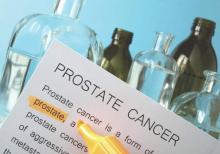Adjuvant androgen suppression with goserelin and radiotherapy at doses of 70-78 Gy improved biochemical disease-free survival of men with intermediate- and high-risk localized prostate cancer when compared against radiotherapy alone, according to results of the EORTC 22991 trial.
“Our results suggest that adding 6-month AS as a concomitant and adjuvant modality improves biochemical disease-free survival even at a dose of 78 Gy, with acceptable adverse effects. Furthermore, for patients with low-volume high-risk localized prostate cancer, our results pave the way to using a combination approach with 78-Gy RT plus a short AS duration. Such an approach should be formally compared with long-term or intermediate duration of AS,” wrote Dr. Michel Bolla, professor of radiation oncology at Grenoble University Hospital, France, and colleagues.
The 5-year biochemical disease-free survival (DFS) for radiotherapy (RT) plus androgen suppression (AS), compared with RT alone, was 82.6% (95% CI, 78.4-86.1) vs. 69.8% (95% CI, 64.9-74.2), corresponding to a hazard ratio of 0.52 (95% CI, 0.41-0.66; P less than .001). At a median follow up of 7.2 years, 118 of 410 patients (28.8%) in the RT plus AS arm and 201 of 409 patients (49.1%) in the RT arm reported events for the primary endpoint of biochemical DFS. Radiation dose had no statistically significant impact on the unadjusted treatment affect, according to exploratory heterogeneity tests (J Clin Oncol. 2016 Mar 14. doi: 10.1200/JCO.2015.64.8055).
The European Organisation for Research and Treatment of Cancer (EORTC) trial 22991 recruited 819 men, median age 70 years, from 37 centers in 14 countries during 2001-2008. Patients had prostate adenocarcinoma T1b to T2a with PSA greater than 10 ng/mL or Gleason score of 7 or higher. External radiation dose levels were selected by the centers: 70 Gy (24.6%), 74 Gy (51.1%), and 78 Gy (24.2%).
There was no significant interaction between RT dose and AS (P greater than .1) in a multivariate analysis. The two arms had similar proportions of second cancers: 57 of 410 patients (13.9%) in the RT plus AS group and 46 of 409 patients (11.2%) in the RT alone group.
The study was supported in part by AstraZeneca. Dr. Bolla reported consulting or advisory roles with Janssen and AstraZeneca. Several of his coauthors reported financial ties to industry sources.


